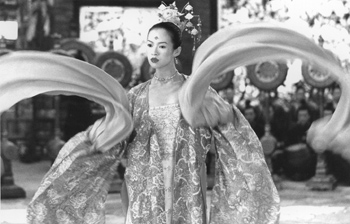![[Metroactive Movies]](/movies/gifs/movies468.gif)
[ Movies Index | Show Times | Silicon Valley | Metroactive Home | Archives ]

Photograph by Bai Yiao Yan If Ever I Should Sleeve You: Zhang Ziyi makes a deadly fashion statement in 'House of Flying Daggers.' Silk Degrees 'House of Flying Daggers' shows off Zhang Yimou's wonderful world of color IF THERE IS any single message that Asian cinema has for us, it is this: Never mess with a blind person. In the Tang Dynasty, Jin (Takeshi Kaneshiro) is a secret policeman working for the emperor. He receives a tip that at that fancy local brothel, the Peony Pavilion, there is a dancing girl connected to that mysterious revolutionary organization, the House of Flying Daggers. At the brothel, Jin seeks out his suspect: a dancing girl named Mei (Zhang Ziyi, Crouching Tiger, Hidden Dragon), who happens to be blind. Pretending to be a drunken playboy, Jin assaults Mei. The plan is to cause a big enough hubbub that the police—meaning Jin's partner, Leo (Andy Lau)—will haul Mei in for questioning, without tipping off her confederates. Mei turns out to be a lethal swordswoman—and almost nothing we've heard previously turns out to be true. The House of Flying Daggers has agents everywhere, even among the emperor's agents. The double and triple crossing is clever enough, but primarily, what House of Flying Daggers has is a genuinely astonishing color scheme. Even if the setting is the middle of the year 800, the trio of lovelorn warriors is dressed in 1890s colors. Their brocaded silks, swirling as these warriors swoop through the air, seem to have come from the era right after the invention of aniline dyes: their robes are of iridescent royal blue, mauve and bottle green. The Peony Palace is essentially an enormous cloisonné box, with enameled walls as gleaming and richly hued as Tiffany glass. In this luscious setting, Mei uses the long prehensile sleeves of her silk robes to snatch a sword out of the hands of an attacker. The battles continue later in an emerald-colored bamboo forest full of lethal punji sticks, sprouting from the ground and flying from the treetops. The final three-way fight, filmed in a Ukrainian national forest, takes place in yellow and crimson-foliaged woods, trembling on the point of snowfall. What an eyeful House of Flying Daggers is! All too frequently, cut-rate computer graphics bleed the color out of our movies, leaving us with nothing but a visual murk that ranges from gray-blue to gray-white. This movie is a demonstration of how relatively little we Americans get in the way of color, despite the notorious cost of our cinema. But like all demonstrations, House of Flying Daggers grows a little wearisome. Zhang Yimou's follow-up to Hero misses the forcefulness of that epic and its fierce central idea: how the hero braved an army to hang a sword of Damocles over the emperor. The off-again, on-again romance between Mei and Jin is repetitious—one too many angry partings between them, one too many advances spurned. ("I thought you were as hot as fire, but in fact you're as cool as water!" says Jin.) And the use of slow-motion fight scenes blunts the essential momentum of the martial-arts film. If the colors are as rich as stained glass, there are times when you feel as if you are sitting and watching a stained-glass window. Pure beauty is exhausting. That's what crumples a man's spine while he's visiting an art museum.
House of Flying Daggers (PG-13; 119 min.), directed by Zhang Yimou, written by Feng Li, Bin Wang and Zhang Yimou, photographed by Xiaoding Zhao and starring Andy Lau and Takeshi Kaneshiro and Zhang Ziyi, opens Friday at selected theaters.
Send a letter to the editor about this story to letters@metronews.com. [ Silicon Valley | Metroactive Home | Archives ]
|
From the December 15-21, 2004 issue of Metro, Silicon Valley's Weekly Newspaper.
Copyright © Metro Publishing Inc. Metroactive is affiliated with the Boulevards Network.
For more information about the San Jose/Silicon Valley area, visit sanjose.com.